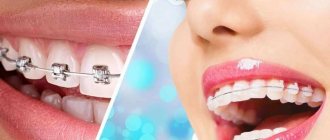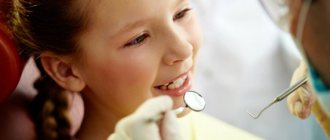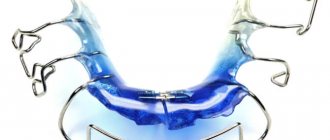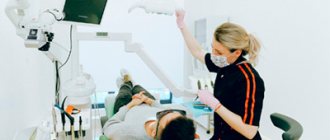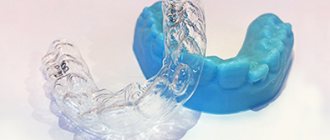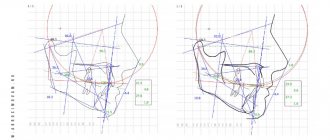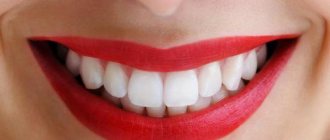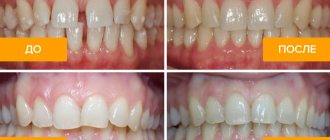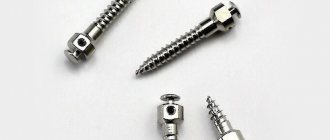The structures are made from individual impressions in a dental laboratory. They are presented as monoblocks with occlusal pads and mechanical elements; they come in single and double jaws. The therapeutic effect is achieved due to the gradual displacement of the dentition.
At the Alfa-Vid clinic, several types of devices are used to treat patients under 15 years of age, which have proven their effectiveness and demonstrated the best results.
Haas apparatus (Marco Rossa)
Used to expand the upper jaw when teeth are incorrectly positioned. The time frame for starting treatment varies from five to ten years. Effectively corrects crossbite and jaw asymmetry, creates conditions for correct tongue articulation. Timely correction with the Marco Ross apparatus prevents the number of indications for installing braces or significantly reduces the time of wearing them. The appliance consists of a plastic base and a screw, providing maximum potential for expansion of the upper dentition. It is attached to temporary molars with orthodontic rings or “claws”, and to canines – with composite material. Depending on the goals and duration of treatment, additional elements may be introduced into the design.
Twin Block
Twin-Block is a structure of orthodontic plates, leveling arches and screws. The principle of operation is to exert mechanical pressure on the dentition. Wearing is indicated for distal occlusion with pronounced asymmetry of the lower part of the face, protruding upper lip and lack of occlusion between the dentition. The greatest effectiveness of the device is observed during the period of active formation of the jaws.
The design is comfortable to wear, does not affect diction, has minimal adaptation time and high aesthetics. It is recommended to wear it constantly and remove it during hygiene and during periods of intense exercise. At the initial stage of adaptation, it is allowed to take off during meals, but in the future, this should not be done, because Chewing processes enhance the healing effect.
Palatal expander
The design is used to expand the upper palate and form the desired bite configuration. The device consists of rigid metal brackets, a tension arc and an expansion screw. It is attached to the teeth using rings or other fasteners. When activated, the expander expands, spreading the palate in the transverse direction.
The device shows the most effective results in children and adolescents at the stage of formation of the dental system. In some cases, the use of an expander is justified in adulthood. The average course of treatment is six months, and the first results are noticeable within a few weeks.
Tongue flap
Incorrect position of the tongue makes it difficult for the teeth to erupt in the upper jaw. Over time, disocclusion (open bite) develops, which leads to disturbances in speech, respiratory and chewing function. Plates with a flap limit the protrusion of the tongue and accustom it to a physiological position. Lightweight transparent structures provide myofunctional and speech therapy, and also prevent various types of jawbone deformities.
Anatomy of the upper jaw
The upper jaw consists of 6 bones connected to each other by sutures. This connection has micromobility due to cartilage tissue and does not fuse completely, like all the bones of the skull, which retain their micromobility throughout their lives.
The upper jaw has a spongy bone structure, which indicates its rather loose and pliable structure. Anatomically, bone trabeculae and pores are located in the thickness of the bone of the upper jaw, and are its main component. The direction of these bony trabeculae dictates the axis of tooth eruption
Pros and cons of technology
The Alf device has a number of undeniable advantages:
- absence of pain and discomfort while wearing;
- invisibility to others (installed on the inner surface of the dentition);
- does not interfere with thorough oral hygiene;
- promotes healthy development of the facial skeleton;
- normalizes breathing;
- does not require much space in the mouth, which maintains normal diction;
- promotes anatomically correct teething;
- blocks the possibility of developing pathologies of jaw closure;
- eliminates the causes of snoring, apnea;
- prevents the occurrence of dysfunctions of the temporomandibular joint;
- creates an ideal balance between all the muscles of the body (due to the shift of the bones of the skull), which ensure the correct physiological position of posture.
Important! After treatment with the A lf device, the risk of re-formation of defects is eliminated.
Among the shortcomings, experts highlight:
- decreased visual acuity or breathing problems due to the movement of bone structures;
- Only a highly qualified specialist can apply the technique in practice;
- impossibility of correcting severe malocclusions;
- cannot be used in patients with a history of allergic reactions to metal;
- high cost of treatment.
In the video, the doctor shares his opinion on the effectiveness of the technique.
Operating principle of the ALF device
The principle of operation of the ALF apparatus was revealed by Darik Nordstrom and his colleagues, and is based on the unlocking and straightening of the 6 bones of the upper jaw, indirectly aligning the dentition. As soon as it is possible to align the bone itself, the tooth is automatically aligned according to the changed axis of the trabecular system of the upper jaw. At the same time, there is enough space for all teeth automatically.
The ALF device has a loop spring structure, which allows, when activated, to apply pressure to the blocked segment of the jaw, but it is also pliable in its loop bends, while providing a soft, non-rigid effect, thereby not blocking the cranial rhythm and breathing of the upper jaw itself.
The rhythm of the upper jaw and the entire skull is called the osteopathic term - cranial rhythm.
The upper jaw makes a rhythmic oscillatory movement, expanding along the median seam and narrowing back, rising slightly anteriorly and falling back. These vibrations occur around its axis, and are normally equal to 8-12 amplitudes per minute (the same amount as the breathing of the entire skull as a whole) and are called inhalation and exhalation -
inflection and extension.
To understand the functioning of the ALF apparatus and unlocking the upper jaw, it is necessary to take into account the biomechanics and micromobility of the entire skull as a whole
Types of removable orthodontic appliances
Some types of devices are mass-produced and selected according to specified parameters. In addition, modern orthodontics offers a large selection of devices made in a dental laboratory using an individual impression.
Doctors at the Alfa-Vid clinic are proficient in all methods of dentition correction with removable structures. They work exclusively with certified products from the best manufacturers in the USA, Germany, and Russia.
Orthodontic plates
Depending on the design, they solve different problems and are used when it is necessary to move and rotate teeth, correct the shape of the jaw and the width of the palate. They fit tightly and are held on the teeth using metal retainers - rings, springs, clasps or screws. Plates are installed on the upper and/or lower jaw; there are also regular and expanding ones. In the latter case, the structure is supplemented with a screw mechanism, when turned, the frame moves apart.
Efficiency is ensured by the possibility of individual adjustment to the anatomical features of the jaw structure. Adaptation takes place in a short time, while the plates do not put pressure on the bone and do not cause pain. Orthopedic structures are worn constantly, removed from the mouth during hygiene procedures and meals.
Clark apparatus (Twin-block)
The two-jaw removable Twin Block design is used in the treatment of children from twelve to fourteen years old. Effectively influences the process of bone growth and formation, allows for successful early correction of malocclusions: loose closure, excessive inclination of teeth, deep overlap of the incisors of the frontal zone. The active treatment period is 9-12 months.
The device is made according to individual impressions in the laboratory. It consists of two plates and supporting spring-clasps, the tension of which is adjusted with screws. The design is easily removed from the mouth during meals and hygiene procedures, however, after adaptation, constant wearing is recommended. The chewing process enhances the therapeutic effect and allows you to achieve results in a short time.
LM-activator
A two-jaw mouthguard made of transparent silicone is effective for eliminating bad childhood habits. It is successfully used for early orthodontic treatment, including during teething.
The advantage is ease of use - the therapeutic effect is achieved by wearing it at night and for at least 2-3 hours during the day. An improvement in the position of teeth is observed within a few weeks, while in young patients the likelihood of developing caries and periodontal inflammation is reduced.
Hinz record
Hinz vestibular plates (Dr. Hinz Dental) produced in Germany are in demand in orthodontic practice when treating children. Developed using new technologies and environmentally friendly materials. There are two sizes in radius:
- 22.5 mm with red ring are intended for small patients with primary dentition;
- 30 mm with a blue ring is used to correct disorders in children during tooth changes.
Vestibular plates normalize the development of the dental system, eliminate harmful myofunctional habits and activate self-regulation processes.
Biomechanics
Normally, the plane of the upper jaw is one of the main horizontal planes in the human body, interconnected with each other and other horizontal planes:
- Plane along the eye line
- Maxillary plane
- Auricular plane (temporal bones)
- Shoulder level plane
- Plane along the pelvic line
BUTRFORTS
As James Carlson points out in his works, with the correct horizontal position of the upper jaw in the skull, there is a balanced distribution of force vectors along the base of the skull and along the buttresses when the occlusion is closed.
The uniform distribution of force vectors during teeth closure sets the symmetry of the cranial rhythm and the symmetrical functioning of the muscular apparatus of the dentoalveolar system.
The even, correct position of the upper jaw in the skull determines the presence of correct occlusion and axis of teeth, both primary and permanent in the subsequent period.
Causes of relapse after braces
Uneven dentition is a consequence of an unevenly positioned asymmetrical upper jaw, which forms twisted bone trabeculae and displaces the axes of the teeth. The lower dentition most often becomes crowded precisely as a result of primary disorders associated with the upper jaw, adapting to it when the teeth are closed.
In this regard, orthodontic treatment with braces is often complicated by the return of the tooth axes to their previous position, that is, relapse. Teeth cannot be forcibly moved using braces systems across their physiological position, dictated by the direction of bone trabeculae and pores. This is fraught with relapses. Even retainers are not able to keep them in this violent position. If orthodontically, only with the help of a brace system, the position of the teeth is aligned, without correcting the position of the position of the skull bones, it will be impossible to create a harmonious occlusion.
Motion device: new generation orthodontics
In modern orthodontics, Motion devices are used for jaw correction, which precedes the installation of braces. The use of this type of mechanical action can significantly reduce the total time of wearing braces.
It is noted that wearing the Motion system does not cause discomfort or pain, is anatomical and in most cases gives excellent and predictable results. Since this system is highly efficient, it is possible to distalize teeth in the range of 3 to 6 mm. Used to correct the upper dentition in patients of different ages.
Motion device in orthodontics
Today, all leading specialists use it, and patients note its amazing effectiveness, visible to the naked eye. Among the advantages of the system is its fairly affordable cost in comparison with similar products.
ALF orthodontics
- ALF orthodontics is the influence and elimination of the direct cause of malocclusion of the dental system. By aligning the bones of the upper and lower jaws themselves, ALF allows the teeth to take a truly correct position, in a non-violent, natural way.
- Often, with minor crowding, we can completely correct the bite using the ALF device without further treatment with a brace system.
- In case of severe occlusion pathology, it is advisable to combine methods in treatment, such as the ALF apparatus, cranial techniques, the GOA method, osteopathic treatment, orthodontic plates and bracket systems, as well as orthopedic restoration of the bite. With this combination of methods, the most effective comprehensive work is carried out to correct not only the bite, but also disorders of the entire body as a whole, including skull asymmetry, posture and the mental component. The ALF device is often used in this version almost as the very first at the beginning of treatment, to unblock the bony components of the upper and lower jaw in combination with eliminating the asymmetry of the skull manually.
- The dental level using braces or therapeutic-orthopedic restoration of the bite is considered the final stage of bite reconstruction, the dental final stage.
- When treated with a brace system, the ALF device also continues its influence on the upper jaw simultaneously with braces, not allowing them (to varying degrees of influence) to organize compression of the skull due to their rigid fixation of the arches and blocking the rhythm of the upper jaw. The ALF device in combination with cranial techniques and osteopathic control allows minimizing the negative effects of the brace system.
Advantages of the Alfa-Vid clinic
Orthodontists at the Alfa-Vid clinic work with all types of fixed appliances and always achieve ideal results! Treatment is aimed at preventing and eliminating bad habits, expanding the jaw arches, normalizing the position of the tongue and the functioning of the masticatory muscles. We take an interdisciplinary and holistic approach to treating malocclusions. The point is that we can handle any orthodontic problem, even if we have to involve related specialists (maxillofacial surgeons, osteopaths, myofunctional therapists) not only from Rostov-on-Don, but also from Moscow.
ALF device technology
The principle of operation of the ALF device is based on the gentle spring pressure of light wires with shape memory on the blocked bones of the upper jaw, without limiting its natural primary respiratory mechanism (PRM).
The ALF device rests on the teeth, exerting pressure on them, but its main effect is
associated with the unblocking of the bones of the upper jaw. Following this, the force vectors of the ALF apparatus installed on the upper jaw affect the frontal and sphenoid bones (as well as other bones of the skull), leading to their release (release from jamming) and unblocking. Compression of the skull associated with a blocked upper jaw, especially with its incisal segment, is almost impossible to eliminate with osteopathic manual techniques without the use of an ALF apparatus (especially with already erupted permanent teeth, the length of the roots of which firmly connects the blocked segments).
Consequently, it is often impossible to manually eliminate osteopathic patterns when they are firmly coupled with disorders of the upper jaw and incisive segment, without using constant persistent pressure from the ALF apparatus aimed at unblocking them and swinging the amplitude of the rhythm of the jaw and skull, removing them from compression.
Conversely, the use of an ALF device for serious cranial dysfunctions and malocclusion pathology will not give the necessary positive results without proper osteopathic manual support. It should be aimed at releasing the sutures, giving the pinched bones their proper micromobility and eliminating the asymmetry in the position of the skull bones.
Device "Crozat"
The Crozat device is a soldered orthodontic device for the upper jaw and lower jaw, compact, soft, does not interfere with diction, stimulates the growth and development of the jaw. Used in complex treatment together with osteopathy, the treatment technique with the Crozat apparatus requires careful and precise activation, allows for symmetrical development of the jaw, restoring its correct volume, breathing of cranial sutures and bones, improving nasal breathing. The device is non-removable, is fixed in the oral cavity movably and is removed only at the moment of activation by the attending physician during the appointment. The wearing period varies from person to person, most often ranging from 6 to 9 months.
It is simply impossible to select a device on your own. The first step to a beautiful smile is scheduling a consultation with an orthocraniodontist.
Why does using ALF not always give 100% results?
- When the upper jaw is severely twisted, it is not possible to unblock it without simultaneously unblocking the frontal and sphenoid bones. This is due to the fact that in most cases the compression of the frontal bone is primary (for example, as a result of birth trauma). It was she who contributed to the shift of the frontal bone and, as a consequence, the formation of bite pathology (secondary manifestation). Consequently, the release of the frontal bone in the sutures and fascia contributes to the release of the upper jaw and gives it a positive vector aimed at its change and expansion. In this regard, the use of one ALF device will not give full positive results.
- Also, the ALF device cannot eliminate intraosseous damage in the thickness of the jaw, if any. Usually it is formed, for example, due to direct trauma to the upper jaw as a result of a blow, or during traumatic extraction of teeth with bone damage. It is also impossible to change the bite and influence it with ALF after jaw osteotomy surgery.
- If the area of intraosseous local damage is small, then the ALF device will work as best as possible with the remaining components of the upper jaw, which will significantly improve the overall clinical picture, with the exception of residual effects in the area of intraosseous damage. The histological trabecular apparatus of bone is capable of changing the overall density both in the direction of compression during compression, and in the direction of development/expansion to a neutral physiological value (according to its reserve capabilities when creating the necessary conditions). In the case of intraosseous damage, the natural physiological compact “packing”/compression of the trabeculae with each other is disrupted. Instead, scar changes and intraosseous calluses/tight adhesions of damaged areas are formed, without the possibility of their further physiological straightening.
Treatment of malocclusion with alf light wire technology
The device acts on the principle of soft power. When worn, the patient does not experience significant discomfort. Thanks to the removable design, the patient can independently monitor oral hygiene. In the case of a braces system, this is more difficult to do. The device is not very noticeable when worn.
Treatment with this method saves time because regular visits to the dentist are made every 8 weeks. In addition, the problem of any elements lagging behind while wearing the device is eliminated. ALF allows you to correct facial asymmetry, make it attractive and rejuvenate.
In the case of the result of treatment after the braces system, anything can happen. Very often the patient's face becomes long. The ALF device has a beneficial effect on the body, as it improves posture and enlarges the airways.
How long does treatment last?
From several months to 2 years, depending on the situation. The duration of treatment is selected in accordance with the patient's parameters. It depends on the state of health and the presence of any pathologies. The correction period can be reduced by using the correct design. The dentist should pay special attention to the facial structure of the skeleton.
When can the alf technique help?
Main signs for installing the device:
- Chin fold
- Slouch
- Mouth breathing
Systematic holistic approach to the treatment of occlusion
The use of ALF 40 years ago proved that the device can correct not only abnormal jaw development. The technology helps to get rid of a number of problems that, at first glance, have nothing to do with the patient’s smile. Common examples include: lack of blood flow to the patient's brain, hearing impairment or persistent tinnitus, any problems with vision or the digestive tract, allergic reactions as a result of breathing through the mouth, and regular back pain.
Read Apparatus for correcting occlusion: types, purpose, use
Therefore, holistic dentistry is becoming more relevant every day. The best treatment results are usually produced by a specialist who is able to treat the body as a whole. That is why a modern orthodontist is obliged to know not only his specialty, but also interdisciplinary methods of therapy.
How does the alf apparatus differ from plate orthodontic appliances?
Installation of ALF involves comprehensive treatment of the patient’s bite. It is this method of treatment that can help achieve your goals. At the moment there is already a huge experience in using the device. The main stages and characteristics of the method are studied. ALF has a systemic effect on the body as a whole. This improves many indicators of the body and completely regulates its condition.
Conclusion
You can find a huge number of positive reviews on the Internet. They prove the effectiveness of the device on the patient. An integrated approach to treatment can significantly improve your health and appearance.
As you can see, treatment with such devices is a truly comprehensive approach that significantly improves the quality of life. When I started wearing the device, I felt like I was born again. Everything changes: posture, the feeling of myself in space, emotions, and awareness of who I am. I became much more productive, and this opened up new opportunities for earning and learning.
But success always depends on the doctor; he must be able to approach the entire body with a holistic approach. A doctor who uses ALF without knowledge of osteopathy can cause the same serious harm to the body as braces. The success of working with this device lies in the doctor’s extensive knowledge of all aspects of medicine. There are only a few specialists of this level in the whole world, but a new life is really worth it.
Conclusions on the use of ALF
- The upper jaw is not rubber and cannot be expanded as we please if something remains that caused it to shrink and keeps it in this position.
- The upper jaw bone of each person has an individual size corresponding to the physiological characteristics of the given organism.
- The bone of the upper jaw has the physiological ability to compress/compress at the histological tissue level, and accordingly can also expand to physiological values (individual for each organism)
- In the conditionally physiological state of the upper jaw (reversible changes), shortening of its skeletal size in the presence of crowded teeth will be easily eliminated using the ALF apparatus with simultaneous alignment of the crowded dentition
- In pediatric orthodontics, the ALF device can prevent the lack of space for erupting permanent teeth, often 13 and 23. Whereas previously, to correct this type of teething disorder, orthodontists made decisions to remove permanent fourth premolars 14 and 24, thereby causing underdevelopment of the upper jaw and its significant narrowing for life.
- The size of the teeth always corresponds to the required physiological size of the teeth for a given upper jaw (with the exception of intrauterine and hereditary pathologies that affect the formation of teeth)\
- In the presence of crowding of teeth and in the absence of conditions for the development of pathology of tooth formation, the most likely reason for the discrepancy between the size of the upper jaw and teeth is a physiological narrowing of the upper jaw (tissue histological level).
Subsequently, underdevelopment of the upper jaw is possible in the presence of pronounced compression during the growth period. Often, for the formation of underdevelopment of the upper jaw, in addition to its compression in the skull, a combination of conditions is necessary:
- The absence of primary teeth during their early removal is a limitation of the growth of the edentulous segment due to the lack of necessary pressure and chewing load on the bone.
- The presence of intraosseous damage to the upper jaw as a result of impacts, traumatic removal of baby teeth - the formation of a scar-changed area with a disturbed bone growth zone.
- Previously, orthodontic treatment of occlusion using devices that block the physiological respiratory rhythm of the upper jaw (system braces in children during the period of active growth, plates without a spring mechanism, use of face masks)
In the case of emerging underdevelopment of the upper jaw, bite treatment aimed at unblocking and expanding the upper jaw must begin as soon as possible. If the underdevelopment of the upper jaw is already formed, treatment with the ALF apparatus may not give the required size of the upper jaw.
“Easy” orthodontics: ALF and Crozat devices
Light force (or light wire) devices such as ALF and Crozat are increasingly attracting interest among potential patients in Moscow and throughout Russia. Mostly, patients try to view them as a newfangled, faster and easier alternative to the usual methods of orthodontic therapy.
But at the same time, there is very little practical and useful information on them on the Internet. And therefore there are a lot of misconceptions and “fairy tales” regarding them...
Photo 1. ALF device (A.L.F.)
Photo 2. Crozat device (Crozart)
Doctors at Orto-Arteli have been using these devices in their practice for a long time, so we can give a description of them. Let us clarify based on frequently asked questions from patients regarding ALF in orthodontics:
Question No. 1. Is ALF an alternative to braces and aligners?
No is not. These are absolutely different devices in meaning, goals and objectives. And, in this regard, one cannot “replace” the other. Just like the hand is not an alternative to the leg.
ALF, dental braces, and other methods are only part of the overall orthodontic treatment. Just one of its stages. We do not recommend considering any device as a panacea (the only “magic and super-effective” pill).
Question # 2: Is ALF an alternative to expanders?
Expanders, ALF (or Crozat) are orthodontic devices for the development of the jaw (upper, in particular). But they have completely different operating principles. And also different goals and objectives. ALF and Crozat, being "fine tuning" tools, can help unblock "pinched" cranial sutures and aid in further development of the same maxilla. While devices for “opening” the palatal suture (development of the upper jaw), it is precisely this “opening” (development) that is carried out. Moreover, much faster and more efficient than ALF
Question No. 3. Is it true that ALF corrects bites faster than all other devices?
Firstly, no device by itself corrects the bite, but can only be part of the bite correction, performing its specific tasks.
And secondly, ALF (Crosat) by definition is “not fast”, since these are light-power devices. And if you use them, for example, for the development of the upper jaw, then this can last for years. Which in itself may not be a bad thing (since the regime is very gentle and physiological). But are you personally ready for this (such a long treatment)?
Question # 4: Can ALF affect the position of the jaws, particularly the mandible?
Maybe, but indirectly. Only as part of general therapy for the development of jaws and dentition and the elimination of cranial deformities. ALF (Crozat) is not used specifically to correct the position of the jaws. There are other methods for this.
Question # 5: When is it appropriate to consider treatment for ALF?
It is better for the patient to never think about it on his own. And the doctor needs to think about when he will find, based on the diagnostic results, indications for its use in each specific clinical case.
Question No. 6. What are the indications for the use of light force devices such as ALF and Crozat?
- development of the upper jaw and upper dentition, especially the development of asymmetrical deformation*
- development of the lower dentition*
- in the complex treatment of cranial deformities, postural problems (see Occlusion and posture). Particularly effective in combination with manual (osteopathic) treatment*
*Used only in the complex treatment of malocclusions (as part of this complex)!!!
Question No. 7. What are the contraindications for ALF and Crozat?
ALF and Crozat have no contraindications as such. They can be used whenever the diagnosis requires it.
Therefore, among the contraindications there can only be indirect factors: when they are used “for no reason”, when they are used because it is “fashionable”, when doctors just want to “make money”, when they want to cure everything at once with the help of ALF, i.e. "one magic device." Therefore, first there must be a diagnosis (search for indications), justification for use (understanding why we use it), agreement with the patient, and only then use.
ALF and Crozat do not work offline!!! Only in complex therapy!!! Subject to understanding the benefits (clinical indications) in each specific case. And with clear coordination of the methods and actions of this complex.
As a result, we can say that ALF and Crozat are far from magical devices. There are no magical things in nature at all.
Like all “medicines,” these devices have indications and contraindications. And indications (as well as contraindications) are solely the responsibility of the doctor. Those. whether you need this or that device is decided by the doctor, and not by the authors of pseudoscientific articles on the Internet that are not related to practice.
Accordingly, if you come to Orto-Artel, then searching for “what to treat , “how to treat,” and “how to treat” is already our concern. We are professionals. And we are ready to help. Without “water” and unnecessary ill-conceived promises.
If you are ready to trust us, contact us! We will be happy to help you. We have a large number of real reviews with before and after photos.
We bring to your attention the types of braces that can be installed in our clinic:
- Metal
- Unligated
- Aesthetic
- Lingual
During a direct examination by a specialist, you will be able to find out your exact diagnosis, as well as receive a referral for diagnosis or a treatment plan.
Sergei Vladimirovich Yashin
author of the article
Dentist-orthodontist, maxillofacial orthopedist
More than 7 years of experience
Treatment of malocclusion with ALF in the absence of a permanent tooth
Often, when trying to cure a malocclusion, the method of removing 1 or more permanent teeth was previously used. In this case, distortion of the dental arch of the upper jaw is accompanied by its shortening and narrowing, and with unilateral removal - deformation of the central line of the palatal suture with a displacement of the middle axis of the entire upper jaw, and with the development of facial asymmetry. The ALF device can return the lost space to restore the desired size of the upper jaw and to balance the symmetry of both the jaw and the entire facial skull as a whole. But to eliminate facial asymmetry associated with the absence of a permanent tooth and a place for it, certain conditions are necessary:
Indication for treatment
Treatment by installing an ALF apparatus should only be done when necessary, in the presence of malocclusion in combination with skull asymmetry, as well as in cases of already developing symptoms of impaired functioning of the body.
The presence of a symptom is not an indication for treatment. The need for treatment is determined by the doctor through a comprehensive comparison of the symptoms and the clinical picture, since the same symptom can be caused by various reasons.
There are also psychosomatic indicators of disorders in the body, they also need to be taken into account and assessed to determine the effectiveness of treatment.
- There is no evidence of traumatic removal with damage to a segment of bone tissue and the formation of a scar-modified bone callus, incapable of physiological expansion.
- Relatively recent tooth extraction. The more years have passed since the loss of space from the extracted tooth, the more difficult it is to expand the upper jaw in this segment.
- Lack of bone fusion of the roots of adjacent teeth. This can occur when permanent teeth are removed as a result of orthodontic treatment, creating rapid traction and moving adjacent teeth into the socket of the extracted tooth. In this case, the fusion of the bone tissue of the socket occurs with the involvement of the roots of neighboring teeth, with their tight adhesion.
- With unilateral removal, asymmetry of the bones of the upper jaw develops with their twisting and displacement of the palatal suture, with the loss of its central location. Following this, the asymmetry spreads to the entire facial skull as a whole. Indirectly through the palatal suture and fascial interrelations, the dura mater twists, and then this dysfunction in a descending manner leads to changes in the spinal column and posture (including subluxation of the atlas - the first cervical vertebra). Long-term adaptation and restructuring of the entire body is formed.
Insufficient anteroposterior size of the upper jaw, its reduction. Following this, there is a posterior displacement of the lower jaw, which takes a forced position with new dental contacts of the upper jaw, which has been reduced by one or more teeth. In this case, the temporomandibular joint gradually begins to be damaged, muscle spasms around the joint begin to develop, pain syndromes, neck pain or migraines appear. The whole body is undergoing a restructuring.
- The narrowing of the upper jaw, caused by the absence of one or more frontal teeth (front teeth), as well as premolars, affects nasal breathing. In this case, compression of the ethmoid bone and vomer develops, they lose their micromobility and are firmly blocked. Gradually, venous stasis begins in the nasal mucosa, swelling increases, and the trophism of soft tissues is disrupted. This leads to swelling and impaired nasal breathing, chronic rhinitis, frequent acute respiratory viral infections (impaired nasal breathing can develop when the upper jaw is narrowed and all teeth are present). Correct expansion/restoration of the size of the upper jaw also leads to unblocking the nasal bones and eliminating the causes of chronic rhinitis, nasal breathing and the sense of smell is restored (80-90%) even with long-term rhinitis (20-30 years)
- The tilt of the upper jaw or its tilt to the side, a violation of the horizontal plane also develops with the unilateral removal of one of the teeth. At the same time, it is possible to ideally align the position of the maxillary plane only if the ALF device fully expands the upper jaw and returns the space from the extracted tooth. At the same time, work with the sutures of the skull is mandatory.
- Narrowing of the upper and lower jaws
- Crowded teeth
- Frequent chipping of teeth and crowns
- Bruxism
- Pathological abrasion of teeth
- Periodontal disorders
- Bite pathology (mesial, distal, straight bite)
- TMJ dislocation
- Dysfunction of masticatory muscles
- Asymmetrical jaw arrangement
- Asymmetry of the facial skeleton
- Symptoms associated with speech, swallowing, and breathing disorders
- Symptoms associated with impaired nasal breathing
- Neuritis of the facial nerves caused by compression of the nerves by the bones of the skull
- Migraines, headaches
- Dizziness
- General weakness of the body and vegetative-vascular syndrome
- Pain in the neck, lumbar region
- Postural disorders
Duration of treatment
World-class doctors believe that dividing dentistry into narrow specialties is an unwise decision. Indeed, in this case, it turns out that the doctor will treat the pathology, and not the sick patient.
And maximum effectiveness can only be achieved when the doctor treats the entire body. For this reason, the orthodontist of our time must not only be fluent in the skills of his specialty, but also regularly study related areas of dentistry and innovative treatment methods.
You can achieve your goals with comprehensive treatment of occlusion, the duration of which can range from 4 months to 2 years.
In each specific clinical case, the duration of the course will be individual. It depends on the patient’s general health and the severity of the diagnosed pathology.
Correct selection of the design will help reduce the correction time. A professional approach in its production is also important. The specialist must take into account the anatomical features of all bone structures of the facial skeleton.
During treatment, the patient must regularly visit the orthodontist for follow-up examinations. This happens at least once a month. The doctor evaluates the dynamics of treatment and adjusts the pressure force of the wire element.
The entire correction process is divided into several stages:
- change in jaw position;
- elimination of skull anomalies;
- bringing occlusion to ideal levels.
If the patient has no defects in the facial skeleton and the functions of the joints are not impaired, doctors skip the second stage of treatment.
The final phase of correction requires the use of a brace system. As a rule, you need to wear them for an average of 3 months.
Remarkable! No other method has such a short treatment period. When using this method, there is no need to consolidate the achieved result, which can take about 4 years. The device is activated up to 10 times a year.
